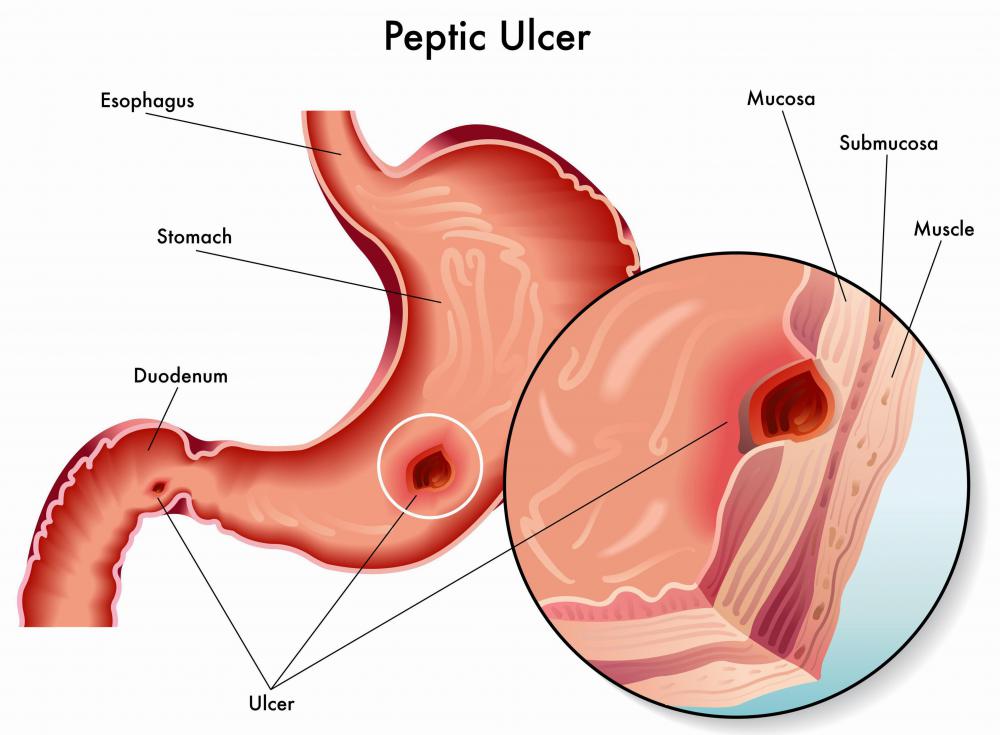At WiseGEEK, we're committed to delivering accurate, trustworthy information. Our expert-authored content is rigorously fact-checked and sourced from credible authorities. Discover how we uphold the highest standards in providing you with reliable knowledge.
What is Radioimmunoassay?
Radioimmunoassay, often known simply as RIA in medical circles, is a laboratory method or technique that measures, with relative accuracy, minute concentrations of hormones and other antigens in the human body. It’s widely used in a number of detection screens, from looking for the presence of drugs like narcotics to scans looking to identify certain disease or allergy markers. The exact way in which it works is somewhat complex, and involves “tagging” or labeling known antigens with radioactive isotopes so that they can be quickly identified when compared against a sample. By contrast, actually performing the test is usually somewhat simple and isn’t typically as costly as many more involved procedures. It requires the use of very sensitive equipment, though, and most hospitals and lab facilities require operators to have specialized training and sometimes even licensing to execute the testing. The procedure is sometimes seen as somewhat dated, and has been replaced in some places by faster techniques that don’t involve the use of radioactive particles. These particles can pose health and safety risks when not handled properly.
How it Works

Generally speaking, radioimmunoassay is a chemical process that allows researchers to see and identify individual particulates out of large groupings. The process is complex, but isn’t usually difficult to execute. First, laboratory technicians must obtain a substance that contains the antigen they are testing for. This antigen is then injected with radioactive chemicals, such as a gamma-radioactive isotope made from iodine or some other substance. The radioactive chemicals cause the antigen to become radioactive, which in turn allows it to be observed under certain settings and with certain specialized equipment.

The radioactive antigen is then mixed with a set amount of antibodies that scientists have determined are appropriate. The antigens and antibodies bind to each other and become one substance. This provides the benchmark or basis for testing. Then, an unknown substance that contains some tiny amount of the antigen is added. This new substance is the substance being tested.
When the new substance, called the “cold” or “unlabeled” substance is added, the antigens in the new substance try to also join with antibodies. As they do, they displace the radioactive substances that were joined to these antibodies. The radioactive substances break away from the antibodies as a result. Scientists can then measure the amount of free radioactive agents that have become unbound to create a binding curve. The binding curve shows the amount of antigens in the unknown substance.
Discovery and Early Uses
The process was first discovered and perfected in the 1950s by American physicians Rosalyn Yalow and Solomon Berson. It was first used to help researchers identify blood volume, iodine metabolism, and insulin levels. Radioimmunoassay has expanded its viability by being able to measure trace amounts of substances using sensitive laboratory techniques. Drugs and hormones are some of the substances the technique can measure today.
More Modern Applications
Radioimmunoassay is considered the pioneer in nuclear medicine radioactive measurements because radioactive substances generally show up with great clarity and accuracy. The uses of the technique are many, and include blood-bank screening for hepatitis, drug detection, tracking viruses, early detection of leukemia and other cancers, and measurement of human growth hormones. They can also aid in the detection of many kinds of ulcers like peptic ulcers.
Though the process is still used in labs around the world, in many places it has been replaced in whole or part by more advanced methods that rely less heavily on radioactive substances. One of the most notable of these is enzyme-linked immunosorbent assay (ELISA), which utilizes a biochemical process and bypasses the need for radioactivity.
Special Precautions and Required Licensing
Radioactive substances can be safe when used properly, but they are quite volatile and need to be handled very carefully. Lab workers doing this and related procedures usually have to wear special protective clothing when working with the particles, and typically need to use specialized machines and equipment, too. These things can add to the net cost, both of the procedure and of operating the lab; some jurisdictions also require technicians to undergo special training for handling radioactive materials. Licenses and certifications may also be required.
AS FEATURED ON:
AS FEATURED ON:












Discussion Comments
@Mammmood - Yeah, I had a test too but it wasn’t a radio immune assay (or something like it). It was this ultrasound thing they put on my neck to supposedly test for clots. Like you, the test results were normal.
The ultrasound technique has its critics, and in principle I think that it should work. But I would have preferred radioimmuneassays instead to see what was really going on inside my blood vessels.
I’m not a doctor but I vaguely recall that this radioimmunoassay technique is used in the detection of blood clots.
I think it’s considered the gold standard for measuring problems in the blood stream. I don’t know the exact process, but I believe that this method proves beyond a shadow of a doubt whether or not you have a blood condition.
Years ago I went to the emergency room for chest pain. They put me through a battery of tests, like treadmill, blood panel, etc. They did everything except this last technique. The doctor had already decided that my condition was normal and thought that I had simply suffered from heartburn or something like that.
Anyway, I’ve been fine ever since, but I had a friend tell me that the tests they put me through are only 50% accurate. He mentioned this last technique, but the doctors didn’t think I needed it.
Post your comments